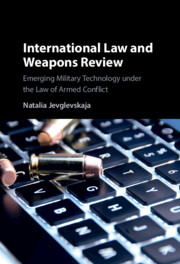Book contents
- International Law and Weapons Review
- International Law and Weapons Review
- Copyright page
- Dedication
- Contents
- Foreword
- Acknowledgements
- Table of Cases
- Table of Treaties and Other Selected Instruments
- Abbreviations
- 1 Introduction
- 2 Article 36: Background and Historical Development
- 3 Interpretative Methodology
- 4 Interpreting Article 36: The Object of Review
- 5 Interpretation of Article 36: The Process and Standard of Review
- 6 Weapons Review Obligation under Customary International Law
- 7 Weapons Reviews under the System of AP I
- 8 Challenges to Article 36 Reviews Posed by Autonomous Weapons Systems (AWS)
- 9 Challenges to Article 36 Reviews Posed by (Autonomous) Cyber Capabilities
- 10 Concluding Remarks
- Index
2 - Article 36: Background and Historical Development
Published online by Cambridge University Press: 16 December 2021
- International Law and Weapons Review
- International Law and Weapons Review
- Copyright page
- Dedication
- Contents
- Foreword
- Acknowledgements
- Table of Cases
- Table of Treaties and Other Selected Instruments
- Abbreviations
- 1 Introduction
- 2 Article 36: Background and Historical Development
- 3 Interpretative Methodology
- 4 Interpreting Article 36: The Object of Review
- 5 Interpretation of Article 36: The Process and Standard of Review
- 6 Weapons Review Obligation under Customary International Law
- 7 Weapons Reviews under the System of AP I
- 8 Challenges to Article 36 Reviews Posed by Autonomous Weapons Systems (AWS)
- 9 Challenges to Article 36 Reviews Posed by (Autonomous) Cyber Capabilities
- 10 Concluding Remarks
- Index
Summary
Chapter 2 explains the procedural character of Article 36 and examines its origins. It first tests the possibility that Article 36 represents a restatement or revised version of a similar provision found elsewhere in the law of armed conflict. To that end, it explores 13 international instruments that regulate the use of weapons in war and that were adopted prior to the 1974-1977 Diplomatic Conference where Article 36 was negotiated. The analysis reveals that none of the pre-existing international compliance mechanisms resemble the AP I weapons review provision. The chapter then examines the drafting materials. Whilst no unequivocal evidence on the motives for adopting a provision on weapons review can be found in the Official Records of the 1974-1977 Diplomatic Conference, there is sufficient evidence to conclude that the key States behind Article 36 were Germany and the United Kingdom. The General Legal Provisions relating to the Conduct of Hostilities and War on Land, operative in Germany since 1961 and mandating that weapons be developed in accordance with the requirements of existing legal regulations, might well be a predecessor to Article 36. [182 words]
Keywords
- Type
- Chapter
- Information
- International Law and Weapons ReviewEmerging Military Technology under the Law of Armed Conflict, pp. 18 - 49Publisher: Cambridge University PressPrint publication year: 2021

